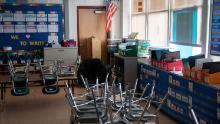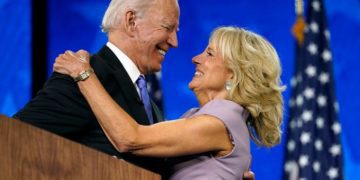[ad_1]
A federal health official stressed that the draft guidance, which was sent to Washington this week, is still under review by the Trump Administration and could change. The draft document was sent to CNN on Thursday by a person familiar with the deliberations.
Details in the document provide a snapshot of what reopening in the United States could look like.
It includes specific guidance for six categories: child care programs; schools and day camps; communities of faith; employers with vulnerable workers; restaurants and bars; mass transit administrators.
For each category, the draft document notes reopening in phases.
People familiar with the deliberations said the recommendations were still under consideration by the White House. But on Wednesday, President Donald Trump signaled he may be unlikely to sign off on guidelines that recommend a return to an altered way of life.
“I see the new normal being what it was three months ago. I think we want to go back to where it was,” Trump said at a meeting with representatives from the restaurant and hospitality industries.
“I want to go back to where it was, that’s where we’re going to be,” Trump said.
Behind the scenes, industry groups have been pressuring the administration to issue nationwide standards for businesses so that a consistent set of advice exists across states. Some have also asked the White House to be mindful of businesses’ bottom lines as they recommend potentially expensive changes to how operations are run.
In his remarks on Thursday, Trump also appeared mindful that half-full restaurants and stadiums wouldn’t provide a sense of normalcy for many Americans.
“I had one restaurant owner come up to me and said, ‘Sir, you know I’m going to be opening up but if I distance too much I have 50 percent of the restaurant I had,’ ” Trump said. “I said, and you’ll also have a worse atmosphere.”
Spacing out in schools
For schools and day camps that are preparing to reopen, the document recommends to consider keeping classes together in order to include the same group of children each day and avoid mixing between groups.
The document also suggests to space out seating and bedding to 6 feet apart if possible, avoid “non-essential” assemblies and field trips, and have students eat lunch in classrooms rather than cafeterias, among other recommendations.
When it comes to child care, the document notes, “In communities that are deemed significant mitigation areas by State and local authorities, child care programs should be closed. However, child care programs can choose to remain open to serve children of essential workers, such as healthcare workers.”
The document goes on to say that all decisions about following these recommendations should be made locally in collaboration with health officials who can help determine the levels of Covid-19 transmission in the community and the capacities of the public health system and healthcare systems in the community.
Face coverings and faith
For faith-based organizations, the document encourages limiting large gatherings, relying on virtual or outdoor services where possible, using a stationary collection box and promoting the use of face coverings at all gatherings.
The document also suggests to avoid or consider suspending the use of a choir or musical ensemble during religious services or other programming, if appropriate within the faith tradition. Instead, the document notes to consider having a soloist or limiting the number of choir members and keep at least six feet apart.
“The federal government may not prescribe standards for interactions of faith communities in houses of worship and no faith community should be asked to adopt any mitigation strategies that are more stringent than the mitigation strategies asked of similarly situated entities or activities in accordance with the Religious Freedom and Restoration Act,” the document notes.
“CDC offers these suggestions that faith communities may consider and accept or reject, consistent with their own faith traditions, in the course of preparing their own plans to prevent the spread of COVID-19.”
Returning safely to work and restaurants
The document also encourages employers to protect employees who may be at higher risk for severe illness from Covid-19 by supporting and encouraging options to work at home or remotely. People at higher risk of severe illness are those with underlying health conditions and older adults.
As restaurants and bars consider reopening, the document notes that they should reopen with limited capacity that still allows for social distancing.
According to the document, restaurants should move toward disposable menus, plates and utensils; switch to single-use condiments; install sneeze guards at cash registers; and avoid salad bars, buffets and self-serve drink stations.
The document also calls for the use of a cloth mask or face covering by employees when near other employees and customers.
For mass transit, the document suggests restricting routes between areas experiencing different levels of coronavirus transmission and to intensify cleaning, disinfection and ventilation.
“Mass transit is critical for many Americans to commute to and from work and to access essential goods and services,” the document states. “This guidance provides considerations for mass transit administrators to maintain healthy business operations and a safe and healthy work environment for employees, while reducing the risk of COVID-19 spread for both employees and passengers.”


















